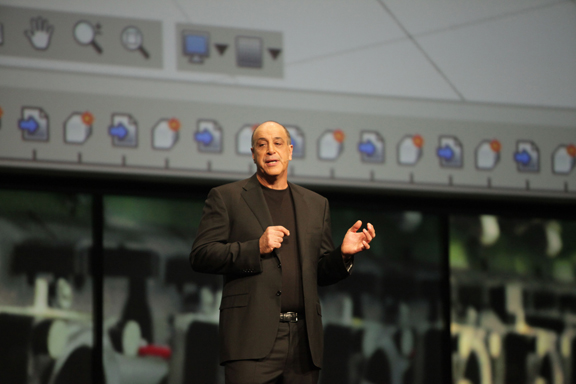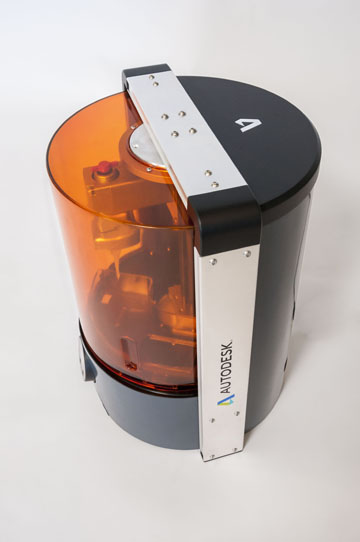
Generative Design currently appears under Autodesk Research, codenamed Dreamcatcher. This shows the type of structural forms possible with automatic optimization algorithms.
Latest News
December 9, 2014
 Autodesk CEO Carl Bass announced that all Autodesk software would be free to students, teachers, and schools anywhere in the world.
Autodesk CEO Carl Bass announced that all Autodesk software would be free to students, teachers, and schools anywhere in the world. Autodesk CTO Jeff Kowalski explained a new concept for computer-automated iterative design, dubbed Generative Design.
Autodesk CTO Jeff Kowalski explained a new concept for computer-automated iterative design, dubbed Generative Design.On Tuesday December 2, the arena inside Mandalay Bay’s Conference Center strained to contain the estimated 10,000 Autodesk faithfuls, waiting for the opening act of Autodesk University (AU) 2014. The first to take the stage was Autodesk CTO Jeff Kowalski. He usually speaks in a careful, measured cadence, which seemed out of sync with the fast-paced techno music that ushered him in. But he commits to his words, declaring them like the next ports of call or anchor drops.
“As wonderful as our creations are, they’re more dead than they are alive,” he said, against a black plate showing a rusted jalopy. “We’ve been forging a path that’s divergent from Nature ... Through technology, we’ve actually been working in opposition to our provenance ... So at Autodesk, we’re starting to look at technology and design itself through the lens of Nature, a complete inversion of the traditional perspective—looking at the natural world through the lens of technology.”
How might engineering software mimic Nature? It might have to become much more autonomous. Kowalski envisions employing machine-learning algorithms to make computers understand “what things are, what they’re related to, and what they do.” He has in mind a system that “learns the same way we do, by referencing mechanical engineering codes, building codes, and part catalogs, even by observing real-world examples, and the outcome is a tool that works in a lifelike manner.”
Such a tool could fundamentally change the way we interact with our hardware and software. “We have to stop telling computers what to do. Instead, start telling them what we want to achieve,” Kowalski said.
Generative Design, Software that Mimics Nature
To Autodesk, mimicking Nature’s iterative approach means coming up with optimization algorithms. Autodesk calls it “Generative Design.” Kowalski said, “[It] starts with your goal. Then it explores all the possible permutations of the solution through successive generations, until the best one is found.”
It’s not a new process, but one that was previously confined to enterprises and researchers with access to data centers, because “the computation would have taken too long,” he added. But now, on-demand high performance computing (HPC), remote hardware, and virtualization make it possible for average designers to “evolve millions of individual options in parallel.”
The nomenclature similarity between Autodesk’s Generative Design and rival Bentley Systems’ Generative Component (GC) deserves some clarification, especially because Kowalski insists they’re different software species. “GC is closer to what [Autodesk is] going for with DesignScript, which largely targets those in architecture,” he explained in the Q&A session with the press. “Generative Design is meant to be applied much more generally, including manufacturing, architecture, and construction.”
Generative Design, Kowalski said, would automate three types of optimization: topology, lattice-based structures, and strut/beam structures. “The algorithms we’re using underneath haven’t been seen in our market so far,” he added. Yes, the software could remove materials to shave off weight, just like other topology optimization software programs do, but “we can also grew the structure computationally,” Kowalski said in his keynote.
Generative Design is currently a research project, dubbed Dreamcatcher. It’s described as “a goal-directed design (GDD) system that enables designers to input specific design objectives, including functional requirements, material type, manufacturability, performance criteria, and cost restrictions ... a new workflow: a fusion of the designer, artificial intelligence, and the cloud.”
 Generative Design currently appears under Autodesk Research, codenamed Dreamcatcher. This shows the type of structural forms possible with automatic optimization algorithms.
Generative Design currently appears under Autodesk Research, codenamed Dreamcatcher. This shows the type of structural forms possible with automatic optimization algorithms.From the Internet of Thing (Singular) to Living Cities
Some might say the Internet of Things (IoT) is the movement to infuse dead designs with characteristics of Life. Incorporating sensors and data would gives vehicles, buildings, and appliances a measure of autonomy and programmatic responsiveness. But Kowalski objects to the term IoT. “[Current devices] don’t even talk each other. They talk to me through my iPhone interface,” he remarked. “It’s not even the Internet of Things—just the Internet of Thing.”
It’s not essential that Kowalski’s devices talk to him. He said, “And I don’t even want them to talk to each other. What I want is for them to exist in an environment where they’re aware of each other’s capabilities, and be conscious of what’s going on in the world.”
In this type of environment, designers and engineers should not be content with product aesthetics and functions. Instead, they should be posing a new set of questions to themselves, Kowalski said. “What should our devices and their environments be aware of? What should they be able to do in response?”
That, some might argue, is the stuff of science fiction: robots created in mid-air, self-assembling infrastructure. But Kowalski doesn’t think it’s that far off. “We are exactly at that technology threshold,” he said.
Autodesk Software, Now Free for All Students
One of the largest rounds of applause during the keynote came when Autodesk CEO Bass announced, “Autodesk is making all of its software available for free to any student, teacher, or school, anywhere in the world.”
The move is philanthropic, as Bass proudly said, but it also comes with a huge strategic benefit—brand loyalty cultivation. “In the long term, the key to all our success is finding well-trained, young people,” he said.
Autodesk education licensing contributes about U.S. $2 million to the corporate balance sheet, Bass revealed in the press Q&A. According to Autodesk’s financial disclosures, revenues for the third quarter of fiscal year 2015 rounds out at U.S. $618 million, an increase of 11% compared to the same quarter last year. In that context, $2 million seems like a negligible sum; yet, the free software distributed will certainly give Autodesk a significant advantage over its competitors in introducing its software titles to aspiring engineers and designers.
Autodesk’s major rivals—Dassault Systemes, Siemens PLM Software, and PTC—offer discounted education licensing, with some free offerings and occasional in-kind donations. But none has gone so far as to declare its software free for the entire education community. If they choose to match Autodesk’s $0 education licensing, it’ll be a boon for all educators and students.
 The design specs of the new Autodesk Ember 3D printer, shown here, would be made available to the open source community.
The design specs of the new Autodesk Ember 3D printer, shown here, would be made available to the open source community.Hack the Autodesk 3D Printer, with the CEO’s Permission
The free education software giveaway is preceded by Bass’s introduction of Spark, the company’s open-source 3D printing software; and the Autodesk Ember 3D printer.
Bass revealed that Spark has attracted partners like HP, ExOne, and Nervous System. Furthermore, he is committing $150 million to a Spark investment fund, “to support entrepreneurs, startups, and researchers who are pushing the [3D printing] limits,” he said.
Ember is currently in the company’s “Explorer Program,” accessible to materials scientists, software developers, research institutions, makers, and industry leaders. But eventually, Autodesk plans to make Ember’s design specs available to the open source community. “[Ember] is a reference implementation to show how much better 3D printing experience can be with integrated hardware and software,” Bass explained. “We’ll be sharing Ember’s design plans with everyone who wants to build their own 3D printer, or even hack one of ours.”
The Shift from Ownership to Access Economy
Five years ago, when Bass revealed his vision for cloud-hosted CAD (”Cloudy with a Chance of Twitch,” December 2009), a good many reacted with skepticism. But today, running CAD from a browser window is no longer theoretical; quite the contrary, many CAD vendors are seeking to augment their desktop licenses with cloud services.
Autodesk’s early start in the Cloud laid the foundation for its next big bet—the software consumers’ migration from perpetual licensing to access-based licensing. In Autodesk Sr. VP Andrew Anagnost’s words from his investor presentation, it’s a “business model transformation.” Cloud services and subscriptions are the cornerstones of Autodesk’s plan to capture the new consumers, who are less likely to desire software ownership, more willing to pay for on-demand access.
Subscribe to our FREE magazine, FREE email newsletters or both!
Latest News
About the Author
Kenneth Wong is Digital Engineering’s resident blogger and senior editor. Email him at [email protected] or share your thoughts on this article at digitaleng.news/facebook.
Follow DE





